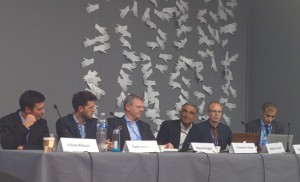COP21 Side-event: From INDCs to 2 Degrees, Bridging the Gaps in Mitigation & Implementation
Date and time: 3 December 2015, 16:30-18:00
Venue: EU Pavilion
Moderator: Laura Cozzi (IEA)
Part I (16.30 – 17.20): Bridging the INDCs and 2 degrees.
A panel of leading scientists presented & discussed their work on how below 2°C pathways can be reached, including the progress made and remaining challenges implied by INDCs
Session summary
Alban Kitous and Toon Vandyck (Joint Research Center)
The publication on INDCs: global energy and climate outlook, provides an analysis at the country level and a global outlook. It starts with economic assumptions and includes several scenarios.
According to the analysis, putting the world on a low carbon pathway goes hand in hand with robust economic growth. We can notice a shift of employment in jobs in the forecasts.
Currently, the INDCs will put the world on a 3 degrees increase trajectory as of now.
Elmar Kriegler (Potsdam Institute for Climate Research)
Delaying actions after 2030 will increase implementation difficulties. Therefore, aggressive mitigation action has to be taken beforehand.
The Paris agreement needs to include strengthening mechanisms to build a bridge between INDCs and the point of staying below 2 degrees. This bridge has to entail the fact of disincentive fossil fuel use.
A credible long term goal from the Paris Agreement is also needed. Policies to incentivize low-carbon energy and disincentive fossil fuel use are complementary.
Explicit commitments in INDCs will send a clear message to investors to foster this shift.
P.R. Shukla (IIMA)
Alternatives development pathways have to be considered to consider how we move into the future. In one scenario we continue to be market based, and in the second, we include the 3 dimensions of sustainable development.
Even with the INDCs, India’s emission are going to triple by 2030, which brings the question of stabilization of emissions.
India’s CO2 per capita will decrease though. India’s INDC will bring the country’s emissions below BAU levels but fall short of the 2 degrees target. Not only ambition, but also trust is a major point to be highlighted in the INDCs,
so that investors know that in case of failure, someone will be ere to support and backup.
Q&A to panel of researchers with the three speakers, also featuring LULUCF experts Nicklas Forsell (IIASA) & Giacomo Grassi (JRC)
Nicklas Foresell and Giacomo Grassi (IIASA)
LULUCF’s role in climate change is paramount. Indeed, 1/3 of GHG emissions are absorbed by forests and another 1/3 by oceans.
That is why it is so important to preserve these ecosystems for climate mitigation. Business as usual is expected to lead to an increase of LULUCF net emissions compared to historical levels.
Full implementation of INDCs will however lead to a decrease of LULUCF. LULUCF will contribute from 20 to 25% of countries’ emission reductions.
Liwayway Adkins (IEA)
Mitigation components in INDCs comprise complication factors such as: mitigation goals as range, conditional targets, non-GHG goals, differentiated GWPs, international carbon markets, accounting (LULUCF, international units), contingencies…
Recommendations: develop rules for land sector and accounting, more information on the implementing policies and linking between short term national targets to long term ambitious goal.
Jean-Charles Hourcade (CIRED)
LCS-RNet: harnessing the animal spirit of finance, poses the question of the accuracy of the 3% GDP growth assumption. We need to link short term data to long term goals.
Another recommendation is to redirect household’s savings, pension funds, insurance schemes and sovereign funds towards long term and sustainable financial investments. Carbon pricing is a pre-condition.
But the pace to which it can be upgraded is too slow to spur the necessary actions in countries such as India or China.
Such carbon pricing might be acceptable to these countries if it is embedded in financial schemes that reduce the financial risks of low carbon investments. The question is how to transform low carbon activities in assets.
Axel Michaelowa (perspectives climate change)
NAMAs has been a bit ignored in the climate dialogue, which focused on INDCs, while they constitute the concrete actions for mitigation.
Market mechanisms and climate finance will be the 2 financial sources of NAMAs. They are based on policy instruments.
The barriers for NAMA development are lack of political support by relevant ministries (finance, economy), lack of stakeholder involvement, lack of information due to confidentiality issues in the private sector, weak institutional arrangements, lack of technology knowledge, and unrealistic hopes of financial opportunities.
- NAMAs are key pillars of INDCs implementation. INDCs will only become stable if they are built on NAMAs. Thus, countries should try to bring consistent assumptions regarding NAMAs.
Part II (17.20 – 18.00): INDC implementation and measurement
Speakers:
Christina HOOD (IEA)
- How does information in INDCs compare with transparency & mitigation goals
Jean-Charles HOURCADE (CIRED – FR) & Jim SKEA (Imperial College – UK)
- Mechanisms to finance INDC commitments
Axel MICHAELOWA (Perspectives Climate Change – CH)
- NAMAs as pillars of a successful INDC
Q&A with panellists

